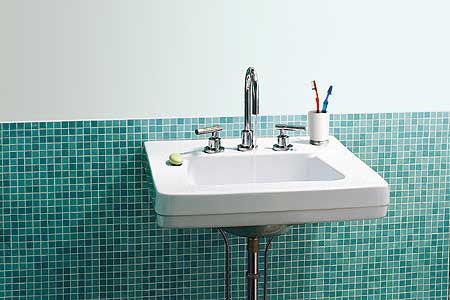Replacing your bathroom faucet is a quick way to refresh the room’s look. While it may seem intimidating to work around plumbing, this is a relatively straightforward do-it-yourself (DIY) project. With our guide—and the correct tools—you can install a new faucet in just a few hours. We’ll walk you through the process step-by-step, including how to tackle common challenges.
Bathroom Faucet Overview
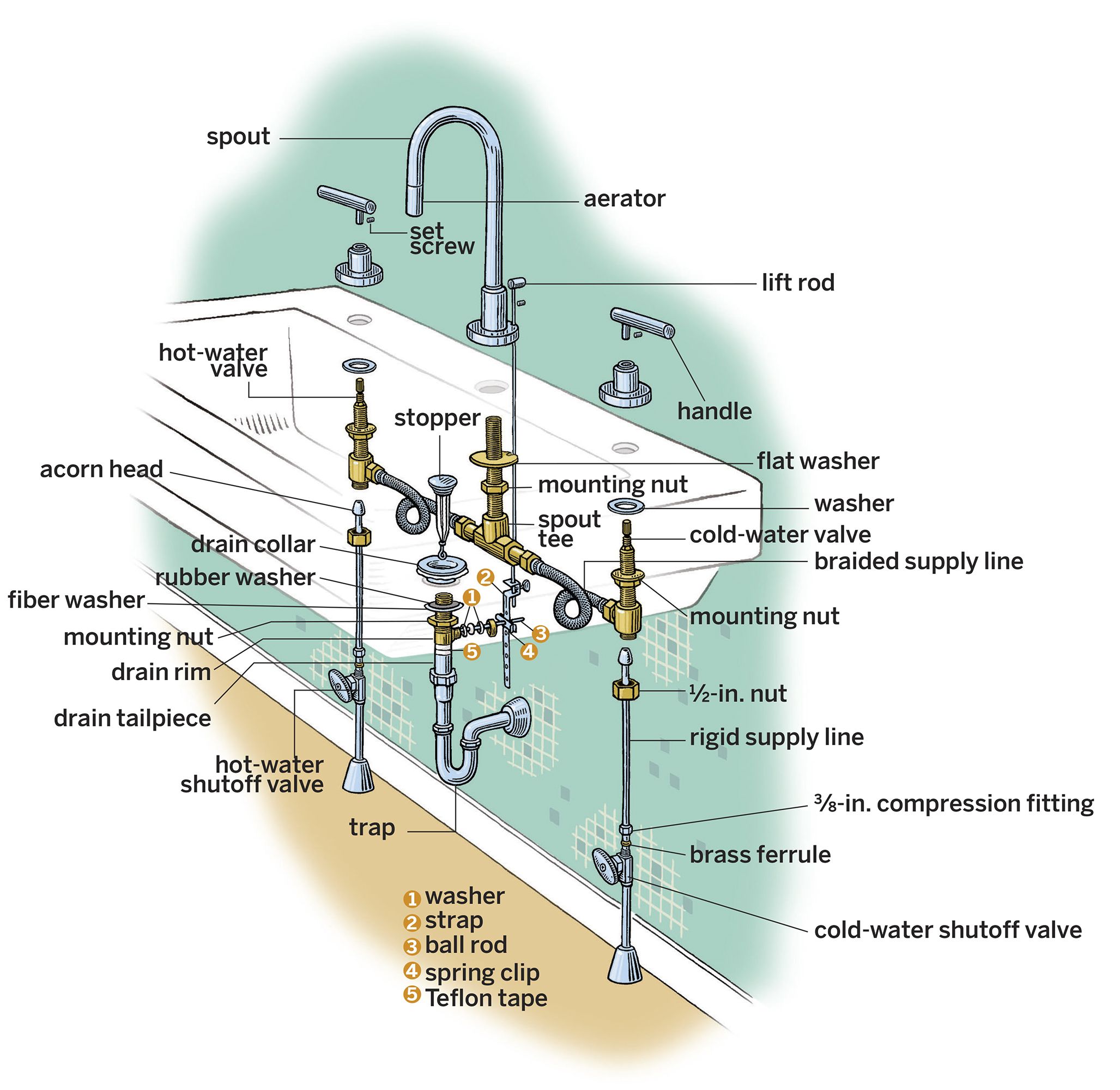
Before starting the replacement process, study the components of a bathroom faucet. Most bathroom sink faucets have three main parts: a center spout and two valves for the handles. Water flows through separate hot and cold supply lines controlled by these valves, then mixes in a tee before exiting the spout.
Standard sinks typically have three holes to accommodate these parts. The distance between these holes determines the type of faucet you can install. After removing the old faucet, measure from center to center on the two outer holes. If the distance is 6 inches or more, you can install a widespread faucet, which requires manually connecting the valves to the mixing tee. For distances of 4 inches, you’ll need a center-spread or mini-widespread faucet, which comes as a single unit.
Most faucets come with all necessary components except for the supply lines connecting the water sources to the valves. You can choose between braided lines, which are easy to install but should be hidden, or rigid lines, which work well when exposed.
Familiarity with the parts will help you troubleshoot any issues that may arise during installation.
Faucet Replacement Tools and Supplies
You’ll need the following tools and supplies to complete your faucet replacement.
Hand Tools
- Adjustable wrench
- Allen wrench set
- Basin wrench
- Flashlight
- Pipe cutter (for rigid supply lines)
- Pliers
- Screwdriver
- Utility knife
Plumbing Supplies
- Bucket or towels for water collection
- Cleaning supplies for sink area
- New faucet assembly
- Plumber’s putty
- Plumber’s tape
- Silicone caulk
- Supply lines (if not included with the faucet)
Step 1: Install the Bathroom Sink Spout

Begin by turning off the hot and cold water shutoff valves under the sink. Remove the old faucet and supply lines, then unscrew the drain collar from the pipe underneath. Clean all holes thoroughly with rubbing alcohol to ensure a proper seal for the new faucet.
To install the new spout, center it in the sink’s middle hole. From underneath, slide the flat washer over the threads, then screw on the mounting nut. This step sets the foundation for your new faucet, so take care to position it correctly.
Thoroughly cleaning the area will prevent any debris from compromising the seal, ensuring a leak-free installation. Careful positioning of the spout will contribute to the faucet’s overall functionality and appearance.
Step 2: Tighten the Nut and Three-Way Spout Tee on the Sink
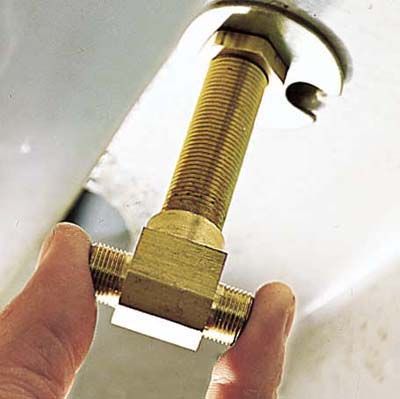
After positioning the spout, hand-tighten the nut. Have someone hold the spout centered on top of the sink, ensuring the hole for the drain stopper’s lift rod faces the back. Use a basin wrench to secure the mounting nut until the spout is firmly in place.
Next, hand-tighten the three-way spout tee at the spout’s bottom, with the openings facing the hot and cold valves. Double-check the spout’s alignment, then lock it into position by tightening the set screw on the back with an Allen wrench. Be careful not to overtighten, as this could damage the sink’s porcelain.
Proper alignment of the spout and secure connections will prevent leaks and ensure smooth operation. Remember, overtightening can be just as problematic as not tightening enough.
Step 3: Install the Hot and Cold Faucet Valves

For each valve, loosen the mounting nut and washer, then push the valve up through the appropriate hole. Attach the escutcheon from above. Hand-tighten the mounting nut from under the sink, then use a wrench for final tightening. Repeat this process for both the hot and cold valves. Proper valve installation is critical in preventing leaks. Take your time to ensure they’re securely fastened and correctly aligned.
Step 4: Fit the Faucet Handles

Connect the two short braided lines to the hot and cold valves, then to each side of the spout tee. Initially, finger-tighten all four nuts. Then, using an adjustable wrench, give each nut an additional quarter-turn. Be cautious not to overtighten, as this could damage the compression fittings and lead to leaks.
Next, fit the faucet handles onto the valves. Adjust them so they face the sides when turned off and face forward when turned on. Secure these positions by tightening the set screws with an Allen wrench. If the braided line is too long, create a loop to prevent kinking.
Step 5: Fit the Rigid Supply Lines

If your faucet valves aren’t directly above the water supply lines, you’ll need to shape the rigid supply lines into an S curve. This allows them to reach the valves and connect straight on. Use a tube bender to carefully form the supply line, starting at the end with the acorn head. Create a second bend in the opposite direction to achieve a graceful zigzag shape. The ends should be offset but parallel to each other.
Note that this step is unnecessary if you’re using flexible braided supply lines.
Shaping rigid supply lines correctly ensures they fit securely without causing undue stress. A clean and precise bend will contribute to a professional-looking and functional installation.
Step 6: Mark and Cut the Rigid Supply Line for the Faucet
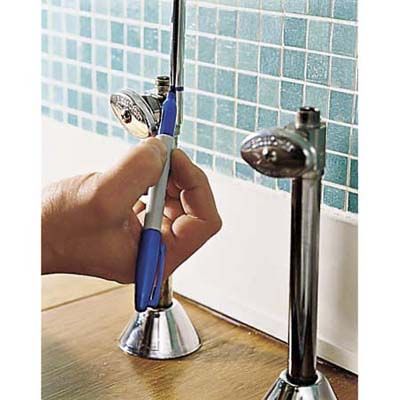
For rigid supply lines, slide a 1/2-inch nut from a compression fitting onto the line and loosely screw it to the faucet valve over the acorn head. Hold the bottom of the line next to the water shutoff valve and mark it 1/4-inch below the edge of the valve’s threaded shank. Disconnect the line and use a pipe cutter to cut along this mark. Repeat this process for the other supply line.
Accurate measurements minimize the risk of errors during installation and water leakage in the future.
Step 7: Hook Up the Supply Lines to the Faucet

The process for connecting supply lines differs slightly depending on whether you’re using braided or rigid lines.
For braided supply lines:
- Screw the 1/2-inch compression fitting to the faucet valve.
- Attach the 3/8-inch fitting to the water shutoff valve.
- Ensure connections are snug but not overtightened.
For rigid supply lines:
- Slide a 1/2-inch nut from a compression fitting onto the supply line (omit the brass ring or ferrule).
- Hand-tighten it to the faucet valve over the acorn head.
- Slide the 3/8-inch nut followed by a ferrule onto the line.
- Hand-tighten the nut to the water shutoff valve over the ferrule.
- Use an adjustable wrench to tighten the 1/2-inch nut an extra quarter-turn.
- Hold this connection steady with pliers while tightening the 3/8-inch nut on the water shutoff valve a quarter-turn.
Repeat these steps for both supply lines. For easier access to the water shutoff valve connection, consider removing the valve’s knob, but be sure to keep the water supply turned off.
Step 8: Install the Drain Collar in the Sink

Remove the old drain assembly using tongue-and-groove pliers. Thread a large mounting nut, fiber washer, and rubber washer onto the new drain rim. Apply a bead of clear silicone to the underside of the new drain collar for a watertight seal.
Slide the drain rim up into the drain hole from beneath. Screw the drain collar onto the rim, ensuring the hole in the drain rim faces the back. Tighten the mounting nut to the sink from underneath. Clean away any excess silicone that squeezes out from under the drain collar.
Wrap the threads of the old drain tailpiece with Teflon tape for a secure connection. Attach it to the drain rim, then reassemble the trap.
Step 9: Connect the Sink Pop-Up Waste Assembly
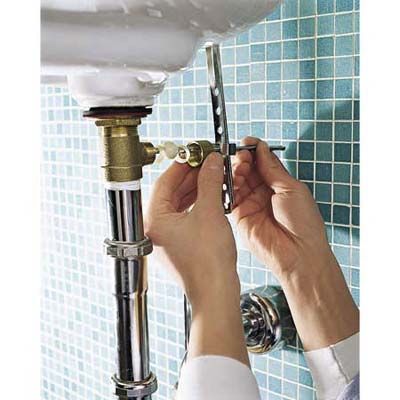
The pop-up waste assembly includes the drain stopper and the rod that controls it. Follow these instructions for assembly:
- Slide a plastic washer, the metal nut from the drain rim, and one side of a spring clip onto the long end of the ball rod.
- Insert the rod end through a hole on the metal strap and secure it with the spring clip.
- Place another washer on the short end of the ball rod and slide it into the drain rim.
- Position the stopper in the drain and catch its hook with the rod.
- Test the stopper’s movement, adjusting as necessary by using a different hole in the strap or modifying the stopper’s hook.
Aligning the stopper properly and ensuring smooth rod movement allows the drain to function as intended.
Step 10: Secure the Rods Below the sink

To finalize the installation:
- Screw the metal nut onto the drain tailpiece, leaving it loose enough for smooth ball movement.
- With the stopper open, thread the lift rod through the back of the spout and the top of the strap.
- Tighten the set screw on the strap to hold the lift rod in place.
- Turn on the water supply and check for leaks.
- Remove the aerator from the spout, run the faucet to flush out any debris, then reattach the aerator.
DIY vs. Professional Faucet Replacement
While many homeowners can successfully replace a bathroom faucet, there are situations where we recommend hiring a professional. Consider hiring a plumber if you run into the following:
- The job requires modifying the sink or countertop
- You discover corroded pipes or valves that need replacement
- Your home has outdated plumbing requiring specialized knowledge
- You’re uncomfortable working with plumbing or lack the necessary tools
A professional plumber can get the job done quickly and correctly, potentially saving you time and preventing costly mistakes.
Bathroom Faucet Maintenance Tips
To keep your new faucet in top condition, follow these tips:
- Clean it regularly with a soft cloth and mild soap, avoiding abrasive cleaners.
- Remove mineral deposits using a 1:1 solution of water and white vinegar.
- Inspect connections periodically and tighten loose parts promptly.
- Replace washers or cartridges if persistent issues arise.
For major leaks or broken connections, consult a professional plumber to avoid potential water damage.
